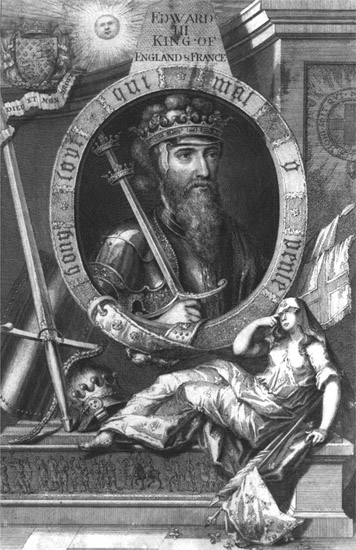
Its decision to support English king Edward III, pictured here, in the fourteenth century’s Hundred Years’ War against France, contributed to the collapse of the Bardi House of Banking. (Library of Congress)
The most prominent of the Florentine merchant houses that formed the nexus of west European banking during the fourteenth century.
The Bardi House held extensive interests in finance, manufacturing, distribution, and com modities trading. The skill of its employees in securing goods and financing extended trade from western Europe to the Far East and made Italy the banking capital of the continent.
The Florentines’ use of financial instruments, among them letters of credit and branch offices, became the framework for the modern banking system. By 1310, the Bardi House had become the wealthiest in Florence and the most politically powerful, owing to the sizable loans it extended to noblemen and popes.

Its decision to support English king Edward III, pictured here, in the fourteenth century’s Hundred Years’ War against France, contributed to the collapse of the Bardi House of Banking. (Library of Congress)
Florence and the rest of northern Italy were caught between the warring factions of the Guelph, supporters of the Roman papacy, and the Ghibellini, supporters of the Holy Roman empire, which by that time was in the control of Germanic rulers. The Florentines’ sympathy was with the Guelph, a decision that made them a favorite with the Catholic Church and its followers.
The Bardi and their Florentine rivals, principally the Peruzzi and Acciaiuoli, dealt in all types of commodities, but their most profitable commodities were wool and grain. An ironclad trading relationship between Florence and Naples served as the basis for the Florentine bankers’ influence and profit.
In 1313, Florence solidified its relationship with that city by allowing King Robert of Naples of the House of Anjou to control its government for nine years. It was a pragmatic gesture borne of a desire for profit and to ease conflicting political pressures from Henry VII of Germany and King Philip IV of France. The Bardi House participated in the arrangement.
The most successful Bardi merchant was Francesco Balducci Pegolotti, who turned his extensive knowledge of the Silk Road into a book called the Practica della Mercatura (The Practice of Trade), which became the fourteenth century’s version of a business manual.
Its most famous employee, though a disgruntled one, was Giovanni Boccaccio, the author of The Decameron and other classics of Western literature. His father, Boccaccio di Chellino da Certaldo, was a high-ranking Bardi employee who wanted his son to join him in the business. The future author spent six loathsome years as a Bardi apprentice and thereafter tweaked his experience in his literary career. In Il Corbaccio, he wrote that the bankers knew nothing of life except how to make money.
The downfall of the Bardi House was the decision to support Edward III, the king of England, in the Hundred Years’ War against France. The war demanded funds, so the king turned to Italian bankers to supply it. The Bardi and Peruzzi Houses’ support of Edward III was in the form of loans to be repaid through the manipulation of England’s lucrative wool trade. By 1340, the wool business had become overvalued and the repayment scheme failed, causing Edward III to default on his debts in 1341. This led to economic instability throughout Europe, and soon after Edward declared insolvency; the king of Naples eventually did the same. The king of France then banished the Bardi and Peruzzi from that country.
In response, the Bardi and Peruzzi houses staged a coup in 1342 of the Florentine government and installed Walter of Brienne, whom they hoped would be more amenable to their financial situation. They were disappointed and ejected him a year later.
Further attempts to salvage their fortunes failed, and the three great Florentine houses declared bankruptcy in quick succession: the Peruzzi in 1343, the Acciaiuoli in 1345, and the Bardi in 1346. By this time the social fabric of medieval Europe had begun to unravel. Florence was struck down by famine and the arrival of the plague in 1348.
The most visible legacy of the House of Bardi are the works of art that it sponsored, among them the frescoes it commissioned from the Florentine artist Giotto to decorate the Bardi chapel in the Church of Santa Croce in Florence.
Ann Saccomano
See also: Bioterrorism; Black Death; Hundred Years’ War; Pegolotti, Francesco Balducci; Wool.
Carswell, Catherine. The Tranquil Heart: Portrait of Giovanni Boccaccio. New York: Harcourt, Brace, 1937.